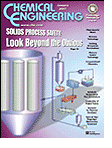Monday, August 31, 2009
Display problem ? Click HERE
Recommended :
- Subscribe FREE - Chemical Engineering
- Tips on Succession in FREE Subscription
 Lower flammable limit (LFL) or Lower Explosive Limit (LEL) is minimum vapor concentration in air which a mixture will burn when an ignition source is present. Upper flammable limit (UFL) or Upper Explosive Limit (UEL) is maximum vapor concentration in air which a mixture will burn when an ignition source is present. Concentration of mixture of vapor in air below LFL/LEL (too lean) or above UFL/UEL (too rich), mixture will not burn even an ignition source is present. Therefore, flammable range or explosive range is concentrations between LFL/UFL and UFL/UEL.
Lower flammable limit (LFL) or Lower Explosive Limit (LEL) is minimum vapor concentration in air which a mixture will burn when an ignition source is present. Upper flammable limit (UFL) or Upper Explosive Limit (UEL) is maximum vapor concentration in air which a mixture will burn when an ignition source is present. Concentration of mixture of vapor in air below LFL/LEL (too lean) or above UFL/UEL (too rich), mixture will not burn even an ignition source is present. Therefore, flammable range or explosive range is concentrations between LFL/UFL and UFL/UEL.
Component LEL & UEL
LFL/LEL and UFL/UEL for some common gases are indicated in table below. Some of the gases are commonly used as fuel in combustion processes.
- Subscribe FREE - Chemical Engineering
- Tips on Succession in FREE Subscription
Component LEL & UEL
LFL/LEL and UFL/UEL for some common gases are indicated in table below. Some of the gases are commonly used as fuel in combustion processes.
| Fuel Gas | (LFL/LEL) (%) | (UEL/UFL) (%) |
| Acetaldehyde | 4 | 60 |
| Acetone | 2.6 | 12.8 |
| Acetylene | 2.5 | 81 |
| Ammonia | 15 | 28 |
| Arsine | 5.1 | 78 |
| Benzene | 1.35 | 6.65 |
| n-Butane | 1.86 | 8.41 |
| iso-Butane | 1.80 | 8.44 |
| iso-Butene | 1.8 | 9.0 |
| Butylene | 1.98 | 9.65 |
| Carbon Disulfide | 1.3 | 50 |
| Carbon Monoxide | 12 | 75 |
| Cyclohexane | 1.3 | 8 |
| Cyclopropane | 2.4 | 10.4 |
| Dimethyl Ether | 3.4 | 27 |
| Diethyl Ether | 1.9 | 36 |
| Ethane | 3 | 12.4 |
| Ethylene | 2.75 | 28.6 |
| Ethylene Oxide | 3.6 | 100 |
| Ethyl Alcohol | 3.3 | 19 |
| Ethyl Chloride | 3.8 | 15.4 |
| Fuel Oil No.1 | 0.7 | 5 |
| Hydrogen | 4 | 75 |
| Isobutane | 1.8 | 9.6 |
| Isopropyl Alcohol | 2 | 12 |
| Gasoline | 1.4 | 7.6 |
| Kerosine | 0.7 | 5 |
| Methane | 5 | 15 |
| Methyl Alcohol | 6.7 | 36 |
| Methyl Chloride | 10.7 | 17.4 |
| Methyl Ethyl Ketone | 1.8 | 10 |
| Naphthalene | 0.9 | 5.9 |
| n-Heptane | 1.0 | 6.0 |
| n-Hexane | 1.25 | 7.0 |
| n-Pentene | 1.65 | 7.7 |
| Neopentane | 1.38 | 7.22 |
| Neohexane | 1.19 | 7.58 |
| n-Octane | 0.95 | 3.20 |
| iso-Octane | 0.79 | 5.94 |
| n-Pentane | 1.4 | 7.8 |
| iso-Pentane | 1.32 | 9.16 |
| Propane | 2.1 | 10.1 |
| Propylene | 2.0 | 11.1 |
| Silane | 1.5 | 98 |
| Styrene | 1.1 | 6.1 |
| Toluene | 1.27 | 6.75 |
| Triptane | 1.08 | 6.69 |
| p-Xylene | 1.0 | 6.0 |
Note : The limits indicated are for component and air at 20oC and atmospheric pressure.
Mixture LFL/LEL & UFL/UELA mixture is combustible / flammable within mixture LFL/LEL and UFL/UEL. Common units for both limits is mole (or volume) percent fuel in air [moles fuel/(moles fuel + moles air)]. A mixture LFL/LEL and UFL/UEL limits can be calculated using the equations first proposed by Le Chatelier in 1891 :
Example
A vapor contains of 20 vol% of Methane (C1), 20 vol% of Ethane (C2) and 60 vol% of Propane (C3). Find LEL of this mixture at 20 degC and Atmospheric pressure (101325 kPaA).
LELC1 = 5 vol% at 20 degC & 101.325 kPaA
LELC2 = 3 vol% at 20 degC & 101.325 kPaA
LELC3 = 2.1 vol% at 20 degC & 101.325 kPaA
LELMix = 1 / [ 0.2/5 + 0.2 / 3 + 0.6 / 2.1 ]
LELMix = 2.55 vol% at 20 degC & 101.325 kPaA
Above LEL may be linked to MOC as discussed in "Minimum Oxygen Concentration (MOC) for Flare Purge". Vapor mixture flammability & explosivity at Operating P & T discussed in this post.
Related Topic
- Inert Gas or Fuel Gas For Flare Purge ?
- Nitrogen Purging - What are the factors you need to consider ?
- Personnel Exposure Time For Heat Radiation
- Heat Radiation For Pain & Blistering Threshold
- Fire related topics...
- Flare related topics...

0 Comments:
Post a Comment
Let us know your opinion !!! You can use some HTML tags, such as <b>, <i>, <a>
Subscribe to Post Comments [Atom]
Home:
<< Home